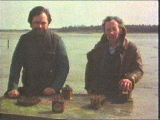 Ever wondered how everyday home appliances such as a fridge, fax machine, or central heating operated? Even if you hadn’t, The Secret Life of Machines series set out to explain simply and clearly how these (and more) items perform their functions. Presented by Tim Hunkin (right) and Rex Garrod, three series of programmes were produced for Channel 4 in 1988, 1991 and 1993 (the third series was entitled The Secret Life of the Office); all pictures shown here are taken from The Secret Life of the Television Set which was the last programme in the first series. Other programmes have since been produced that have names prefixed with “The Secret Life of…” (e.g. The Secret Life of the Zoo), but they are unrelated to The Secret Life of Machines/The Secret Life of the Office.
Ever wondered how everyday home appliances such as a fridge, fax machine, or central heating operated? Even if you hadn’t, The Secret Life of Machines series set out to explain simply and clearly how these (and more) items perform their functions. Presented by Tim Hunkin (right) and Rex Garrod, three series of programmes were produced for Channel 4 in 1988, 1991 and 1993 (the third series was entitled The Secret Life of the Office); all pictures shown here are taken from The Secret Life of the Television Set which was the last programme in the first series. Other programmes have since been produced that have names prefixed with “The Secret Life of…” (e.g. The Secret Life of the Zoo), but they are unrelated to The Secret Life of Machines/The Secret Life of the Office.
 A special feature is the use of (often humourous) cartoons that are used to illustrate ‘moments in history’ which are relevant to the appliance under discussion. This picture is taken from a cartoon used to show the moment when it was discovered that selenium can cause an electrical voltage to change dependent on the amount of light shining on it.
A special feature is the use of (often humourous) cartoons that are used to illustrate ‘moments in history’ which are relevant to the appliance under discussion. This picture is taken from a cartoon used to show the moment when it was discovered that selenium can cause an electrical voltage to change dependent on the amount of light shining on it.
 Tim Hunkin (the main presenter and architect of the series) may look exactly like the stereotypical image of “the professor”, but contrary to this he presents technology in a very straightforward and easy to understand manner and manages to do so in a way that can keep the interest of both novices and experts alike. His secret is possibly that if you’re not afraid of technology and you understand how an item works you can “deconstruct” an item into its various simpler components, and also avoiding unneccesary complexity when explaining how something operates.
Tim Hunkin (the main presenter and architect of the series) may look exactly like the stereotypical image of “the professor”, but contrary to this he presents technology in a very straightforward and easy to understand manner and manages to do so in a way that can keep the interest of both novices and experts alike. His secret is possibly that if you’re not afraid of technology and you understand how an item works you can “deconstruct” an item into its various simpler components, and also avoiding unneccesary complexity when explaining how something operates.
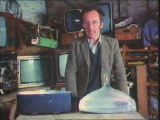 So how did Tim get into television? After gaining a Cambridge degree, he took on a series of bizarre commissions ranging from firework displays to mechanical sculptures. Back in 1972 he had drawn some cartoons for the Cambridge University newspaper Stop Press (the first one was about drawing cows!); this lead to a whole series of witty and factual cartoons for the Sunday Observer magazine colour supplement from 1973 to 1987 entitled “The Rudiments of Wisdom”, covering everything from acids to zoos (they were republished later in a book). Anticipating change at The Observer, Tim developed a proposal for a television series and his agent sent it to Channel 4. The rest, as they say, is history.
So how did Tim get into television? After gaining a Cambridge degree, he took on a series of bizarre commissions ranging from firework displays to mechanical sculptures. Back in 1972 he had drawn some cartoons for the Cambridge University newspaper Stop Press (the first one was about drawing cows!); this lead to a whole series of witty and factual cartoons for the Sunday Observer magazine colour supplement from 1973 to 1987 entitled “The Rudiments of Wisdom”, covering everything from acids to zoos (they were republished later in a book). Anticipating change at The Observer, Tim developed a proposal for a television series and his agent sent it to Channel 4. The rest, as they say, is history.
 Don’t try this at home kids! (Or for that matter, adults as well!) Who else would probably construct their own plasma lamp using the high voltage line output transformer from an old television set?
Don’t try this at home kids! (Or for that matter, adults as well!) Who else would probably construct their own plasma lamp using the high voltage line output transformer from an old television set?
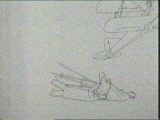 Humour can help make something more memorable, as many academic lecturers are sometimes keen to point out. A cartoon showing that the electronic-scanning Marconi-EMI system cameras (as opposed to the large fixed-position Baird mechanical scanning cameras) were much more versatile by showing someone using one to record a flying aircraft, and then showing the poor camerman being knocked over by the low-flying aircraft!
Humour can help make something more memorable, as many academic lecturers are sometimes keen to point out. A cartoon showing that the electronic-scanning Marconi-EMI system cameras (as opposed to the large fixed-position Baird mechanical scanning cameras) were much more versatile by showing someone using one to record a flying aircraft, and then showing the poor camerman being knocked over by the low-flying aircraft!
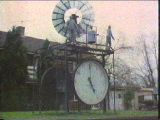 So what do Tim and Rex do when they’re not making television programmes? Well they make models and other mechanical devices for various organisations such as exhibitions and television programmes, and these were often featured to illustrate concepts throughout the series. This wind-powered mechanical clock was developed for the Liverpool Garden Festival some years ago.
So what do Tim and Rex do when they’re not making television programmes? Well they make models and other mechanical devices for various organisations such as exhibitions and television programmes, and these were often featured to illustrate concepts throughout the series. This wind-powered mechanical clock was developed for the Liverpool Garden Festival some years ago.
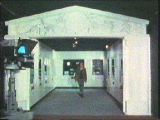 Tim Hunkin also designs and builds a lot of those ‘hands-on’ museum exhibits that interact in some way with the visitor; he designed this section for the National Museum of Photography, Film and Television in Bradford, Yorkshire. Amongst other commissions he has also developed for the Science Museum in London.
Tim Hunkin also designs and builds a lot of those ‘hands-on’ museum exhibits that interact in some way with the visitor; he designed this section for the National Museum of Photography, Film and Television in Bradford, Yorkshire. Amongst other commissions he has also developed for the Science Museum in London.
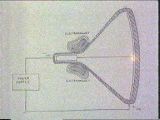 Here is an example of a display from the Bradford museum, showing how an electron beam generates a spot of light when it hits the phosphor-coated front surface of the cathode-ray tube.
Here is an example of a display from the Bradford museum, showing how an electron beam generates a spot of light when it hits the phosphor-coated front surface of the cathode-ray tube.
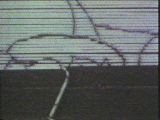 Tim and Rex are not afraid of using anything unusual to illustrate something that they are trying to explain – here they are using string with ink dots on it to illustrate how a television picture in constructed using scanning lines and dots of varying brightness.
Tim and Rex are not afraid of using anything unusual to illustrate something that they are trying to explain – here they are using string with ink dots on it to illustrate how a television picture in constructed using scanning lines and dots of varying brightness.
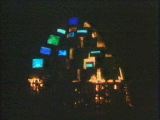 To conclude the first series they built an amazing funeral pyre consisting of old television sets which were faulty in some way but were not worth repairing. The stack of sets were all switched on when the flames were lit, and as the end credits rolled the TV screens flickered and died in turn as the flames rose higher and higher. However it has now been revealed that they wrongly thought the end credits would be less than a minute long therefore the fire was designed to burn quickly, meaning that they had to make the most out of using a relatively small quantity of film footage.
To conclude the first series they built an amazing funeral pyre consisting of old television sets which were faulty in some way but were not worth repairing. The stack of sets were all switched on when the flames were lit, and as the end credits rolled the TV screens flickered and died in turn as the flames rose higher and higher. However it has now been revealed that they wrongly thought the end credits would be less than a minute long therefore the fire was designed to burn quickly, meaning that they had to make the most out of using a relatively small quantity of film footage.
The programmes still have a cult following both in the UK and abroad; they can be legally watched on YouTube or downloaded from various sources and are well worth watching, even if some of their content is now inevitably out of date. Nowadays televisions are basically a computer connected to a wide-screen flat display that’s constructed using either LCD (usually with LED backlighting) or OLED technology; they have much more common with a laptop or tsblet/smartphone compared to models using the now-obsolete CRT.
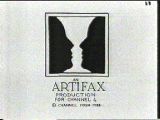 The programmes were mainly Tim Hunkin’s own work, though he had assistants to help him with various tasks such as production. Tim feels that although the shows were popular there was a danger that they were becoming “too formula-based”, so there are no further plans for any more “Secret Life” programmes – however in 1998 he planned to develop a TV series about photography which unfortunately didn’t materialise. Meanwhile he has numerous projects to keep him occupied; he gave a Science Museum talk entitled “Illegal Engineering” which was all about security and safe-cracking, and recent commissions include a Pirate Practice arcade machine installed at Southend Pier in 2012. He also has a “mad arcade of home-made machines & simulator rides” at Southwold Pier in Suffolk entitled “The Under The Pier Show” as well as machines at Novelty Automation based in London. Rex was last seen on the programme Robot Wars as part of a team which lost in a final.
The programmes were mainly Tim Hunkin’s own work, though he had assistants to help him with various tasks such as production. Tim feels that although the shows were popular there was a danger that they were becoming “too formula-based”, so there are no further plans for any more “Secret Life” programmes – however in 1998 he planned to develop a TV series about photography which unfortunately didn’t materialise. Meanwhile he has numerous projects to keep him occupied; he gave a Science Museum talk entitled “Illegal Engineering” which was all about security and safe-cracking, and recent commissions include a Pirate Practice arcade machine installed at Southend Pier in 2012. He also has a “mad arcade of home-made machines & simulator rides” at Southwold Pier in Suffolk entitled “The Under The Pier Show” as well as machines at Novelty Automation based in London. Rex was last seen on the programme Robot Wars as part of a team which lost in a final.
More information about The Secret Life of Machines including how to watch them and what Tim Hunkin has been up to more recently can be found on Tim Hunkin’s own website.